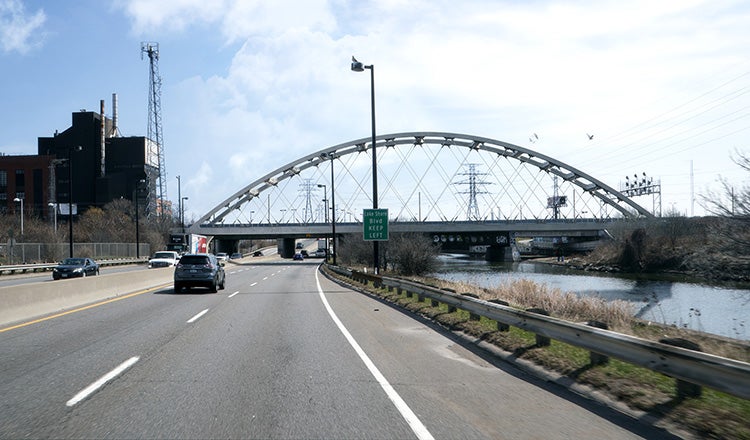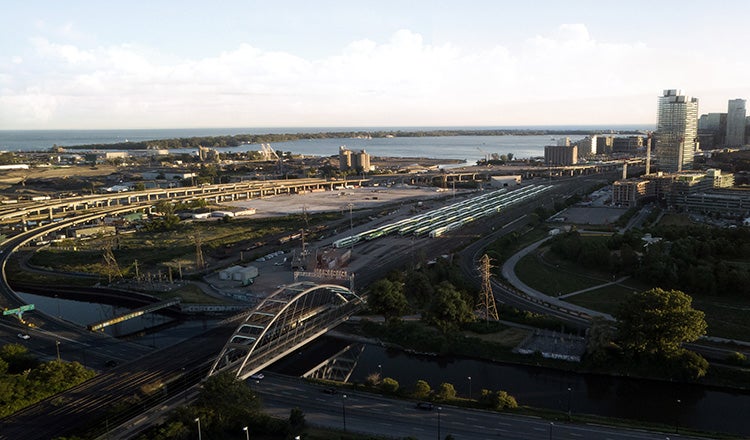Lower Don Bridge

Lower Don Bridge
The Lower Don Bridge, part of Toronto’s new Ontario Line subway project, crosses the Don River in the West Don Lands and Riverside neighborhoods.
The new structure will be a steel network tied arch, carrying two tracks over the Don River and Don Valley Parkway. The span length will be 394 feet with an out-to-out width of 45 feet. The maximum height of the arch, center to center, is 79 feet.
Suited for the Future of the Area
The bridge design was developed for the revitalized future of this historic Toronto neighborhood. Historically an industrial area with little architectural context with which to constrain the vision, HDR designed the bridge to enhance the user experience in a transformed future context. The city and Metrolinx plan to encourage a vibrant renewal of the area into a transit-oriented community, including developing the site of an adjacent abandoned factory into the East Harbour Transit Hub to serve both the Ontario Line and GO Transit.
Metrolinx advocates a philosophy of design excellence — emphasizing graceful and subtle solutions that fit the purpose — and therefore the bridge design focused on modest, elegant structural details. The Vierendeel lateral bracing between the arch ribs was designed with a variable spacing to complement the aesthetic lighting plan along with subtle flares to add visual interest. Diffused aesthetic lighting was designed to enhance the overall volume of the bridge rather than emphasize individual structural members, resulting in a unique visual impact. Hanger cable connections are designed with low-profile sockets which provide a clean, sleek design.
Sized and Shaped to Fit the Site
The tied arch structure was chosen for its ability to span the necessary distance without piers that would impact the Don River and Don Valley Parkway underneath. Its shallow structural depth provides more vertical clearance over the parkway and reduces impingement on the hydraulic opening of the Don River when compared with other structure forms. More common structure types such as a deck girder would require piers in the river, which isn’t feasible; long-span bridge types such as cable-stayed were not a good fit due to limited anchorage locations and structure cost.

Site geometry was extremely challenging, requiring the bridge to use a vertical profile which connects the Don Yard tunnel portal just to the west with the new East Harbour Transit Hub to the east — while maintaining vertical clearance over the parkway. In addition, the bridge must be constructed within very close proximity to the adjacent GO Transit bridge, for which service cannot be interrupted. Careful collaboration among the Lower Don Bridge and the adjacent segment design teams was required.
Abutments and foundations were located with careful consideration of flood risk and subsurface conditions. The Don River is prone to flooding that can create significant traffic impacts on the parkway, so abutments were placed outside of flood limits. Challenging subsurface conditions also impacted foundation placement. The quality of fill presented a risk of soil liquefaction that required additional seismic studies and analysis to confirm the appropriate size and capacity of foundation structures. The chosen foundation design uses 8-foot diameter drilled shafts with rock sockets. On the west end of the site the depth to bedrock is about 130 feet, while on the east end depth to bedrock is about 65 feet.
The many utilities in the area also had to be carefully considered in locating the abutments and orienting the structure to the site. In particular, a sewer tunnel is under construction near the west bridge abutment, so the design was analyzed to ensure that future applied loads from the bridge would not damage the tunnel.

Unique Construction Scheme Envisioned
As part of the design plans, a unique construction sequence is envisioned to solve challenging site constraints. In addition to the nearby existing bridge, overhead power transmission lines will pass directly above the west abutment eliminating the potential for conventional craned construction for the arch span. And buried high voltage hydroelectric transmission lines are just west of the abutment.
Typically, tied arch bridges are either built-in-place or the entire arch system is erected off-site and moved into place during a short-term closure of the roadway below. Neither conventional construction option was considered feasible for the Lower Don Bridge due to the extensive falsework that would be required over the heavily travelled Don Valley Parkway and the desire to minimize traffic impacts.
The conceptual construction sequence presented in the plans assumes the contractor will build a temporary trestle for cranes and equipment in the river and use a falsework system over the river to assemble the eastern portion of the arch span, along with temporary bracing members. During a weekend closure of the parkway, the partial arch span could then be rolled longitudinally into place over the parkway using self-propelled mobile transport units. In a separate operation, the western portion of the arch span could be assembled nearby and rolled into place beneath the overhead power lines. Finally, the middle section would be constructed in place to connect the two partial assemblies and complete the arch span. The selected contractor will determine the final erection sequence, with due consideration of the site constraints and their preferred means and methods, pending final review and acceptance by Metrolinx and HDR.








